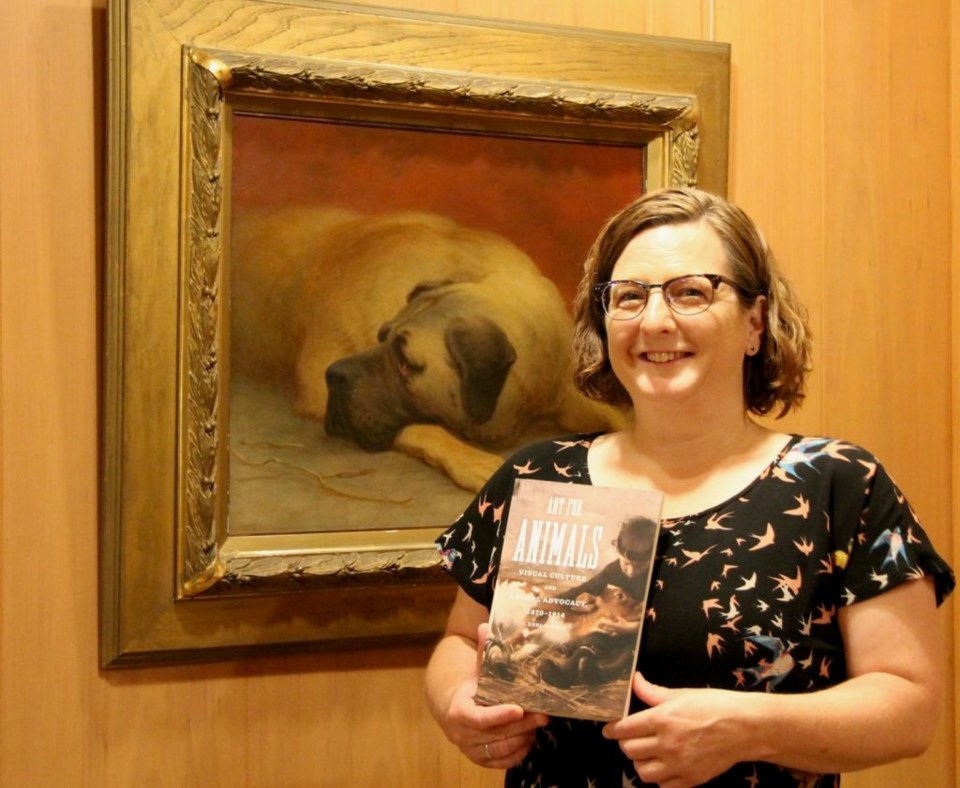
Art, animals, compassion and advocacy.
Keri Cronin, art historian and associate dean at Brock University, spoke of how these are connected at the Arts for Animals discussion held Saturday at the RiverBrink Art Museum in Queenston.
Last year, she published Art for Animals: Visual Culture and Animal Advocacy, 1870–1914.
Her work ties in with one of the museum’s current exhibitions, entitled Menagerie, which is a representation of animals in art history. The collection includes depictions of animals and birds by various artists, with assembled prints, paintings and sculptures highlighting the complex relationships humans have with the natural world.
Cronin says she has great interest in animal rights, animal welfare and how people can make the world a better place for animals.
She says co-existence with animals, wild or domestic, is important, especially with those who want to be activists for environmental issues, which she sees in university students.
Art for Animals focused on pieces used for animal advocacy in the late 19th and early 20th centuries. Though the book focuses on research described as being “historically grounded,” she says many of the issues are as relevant today as they have ever been.
In her presentation, Cronin shows and explains why a variety of paintings, advertising campaigns and print articles depicted the role of art as “significant and crucial to getting their point across,” and in changing minds and attitudes.
The animals she focused were dogs and horses — dogs because of their loyal companionship to people, and horses because of how they symbolize social status.
One example Cronin provided was animal welfare advocates protesting the “fashionable cropping” of a non-working horse’s tail. The cropped-tail horses were featured in many paintings by British artist George Stubbs.
“Occasionally, the cropping would be very extreme, and it would actually hurt the horses by cutting into the bone,” she says. “But more often they were concerned with the fact that the horse couldn’t defend his or herself from things like flies and so it was very annoying, sometimes causing disease.”
Cronin says because paintings depicted the cropped tail as a status symbol, it became more “fashionable,” however, advocates saw this as suffering.
It may have not been one of the “worst forms of animal cruelty,” she says, but is more about perspective and how the advocates viewed it.
Print campaigns came in the form of publications, one of which was called the Band of Mercy Advocate. This magazine focused on humane education and was a formal program, directed mostly to children, to be kind to animals. Adults were also educated through formal programs talking about how a cart horse should not be left out at night without a blanket when it’s cold and that dogs should have enough food and water.
These campaigns helped people see animals not just as tools for transportation or work, but as living, sensing beings “that get hungry, cold and scared,” she says.
“Activists really drew on art to get their message across. They spent a lot of money and, in some cases, a lot of money they didn’t have.”
A lot of very famous painters had their work brought into these campaigns, sometimes later in history, when they were not around to approve of it, she says.
In addition, many art pieces and pictures can and were taken out of the artist’s original context.
“Once the original context is put into a different context, new meanings can be made, which is a good reminder that meanings of images aren’t static.” Cronin says. There’s no universal way of reading a picture — the viewer and the context shape the meaning, she adds.
“Moving an image out of a gallery and putting it in a newspaper or magazine, for instance, will change the way we engage with it.”
In current times, with graphic images being used in social media to raise awareness, Cronin says some viewers are traumatized to the point where they don’t know what to think or do.
“They can have a place in activism, however, it’s important that they are used carefully. Then, by taking it one step further, following up with a positive story, such as a rescue, or figuring out a way to become involved,” she says.
Cronin’s research took her to Britain where a majority of the research was conducted at the British Library in London, and also to the Massachusetts Society for the Prevention of Cruelty to
Animals in Boston, New York City and Toronto.
The thought that piqued Cronin’s interest was “how activists in the past have used art, to tell stories about animals and to try and make the world a kinder, gentler place for them.”
Cronin hopes readers of her book and discussion participants think differently about how they portray animals
and the overall relationships with the people they share the planet with, no matter what environment – wild or domesticated.
To learn more about Cronin’s research and writing initiatives, visit kericronin.com.


